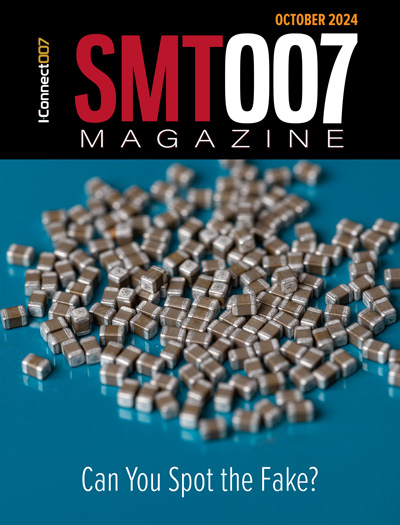-

- News
- Books
Featured Books
- smt007 Magazine
Latest Issues
Current Issue
The Rise of Data
Analytics is a given in this industry, but the threshold is changing. If you think you're too small to invest in analytics, you may need to reconsider. So how do you do analytics better? What are the new tools, and how do you get started?

Counterfeit Concerns
The distribution of counterfeit parts has become much more sophisticated in the past decade, and there's no reason to believe that trend is going to be stopping any time soon. What might crop up in the near future?

Solder Printing
In this issue, we turn a discerning eye to solder paste printing. As apertures shrink, and the requirement for multiple thicknesses of paste on the same board becomes more commonplace, consistently and accurately applying paste becomes ever more challenging.
- Articles
- Columns
Search Console
- Links
- Media kit
||| MENU - smt007 Magazine
DRAM Manufacturers Gradually Resume Production, Impact on Total Q2 DRAM Output Estimated to Be Less Than 1%
April 10, 2024 | TrendForceEstimated reading time: 2 minutes
Following in the wake of an earthquake that struck on April 3rd, TrendForce undertook an in-depth analysis of its effects on the DRAM industry, uncovering a sector that has shown remarkable resilience and faced minimal interruptions. Despite some damage and the necessity for inspections or disposal of wafers among suppliers, the facilities’ strong earthquake preparedness of the facilities has kept the overall impact to a minimum.
Leading DRAM producers, including Micron, Nanya, PSMC, and Winbond had all returned to full operational status by April 8th. In particular, Micron’s progression to cutting-edge processes—specifically the 1alpha and 1beta nm technologies—is anticipated to significantly alter the landscape of DRAM bit production. In contrast, other Taiwanese DRAM manufacturers are still working with 38 and 25nm processes, contributing less to total output. TrendForce estimates that the earthquake’s effect on DRAM production for the second quarter will be limited to a manageable 1%.
Minimal impact from earthquake leads to limited benefit as increases to Q2 DRAM contract prices expected
Following the earthquake, TrendForce reported a widespread halt in quotations for both contract and spot DRAM markets. Since then, spot market quotations have largely resumed, but contract prices have not fully restarted. On the day of the earthquake, Micron and Samsung completely stopped issuing quotes for mobile DRAM, with no updates provided as of April 8th. On the other hand, SK hynix took a proactive approach by resuming quotations for smartphone customers on the day of the earthquake. SK hynix’s proposed price adjustments for Q2 mobile DRAM are notably more moderate compared to other suppliers, likely moderating pricing strategies across the industry. TrendForce anticipates a seasonal contract price increase for Q2 mobile DRAM of approximately 3–8%.
For server DRAM, the earthquake primarily affected Micron’s advanced manufacturing processes. Consequently, TrendForce suggests that the final sale prices for Micron’s server DRAM could rise, though the exact direction of future prices awaits further observation. On the HBM front, the majority of Micron’s production of HBM 1beta and TSV is based in Hiroshima, Japan. This location was not impacted by the earthquake, leading to stable supply levels and unchanged prices.
The spot market has seen some module makers, such as Kingston and ADATA, recommence quoting without adjusting prices upwards, underscoring the earthquake’s limited capacity to propel price increases. Given the scarcity of DDR3 inventory, there remains some upward pricing potential, whereas the abundant inventory levels for DDR4 and DDR5, paired with tepid demand, suggest that the slight price elevations caused by the earthquake are expected to normalize swiftly.
Suggested Items
Weak Demand Outlook and Rising Inventory and Supply Pressure DRAM Prices Down for 2025
11/18/2024 | TrendForceThe fourth quarter is a critical period for setting DRAM contract prices. TrendForce’s latest research reveals that prices for mature DRAM processes such as DDR4 and LPDDR4X are already trending downward due to ample supply and declining demand.
Weak Consumer Demand Leads to 28% Decline in DRAM Module Revenue in 2023
11/07/2024 | TrendForceTrendForce’s latest analysis reveals that the global revenue for the DRAM module market reached US$12.5 billion in 2023—a YoY decline of 28%
DRAM Suppliers Must Carefully Plan Capacity to Maintain Profitability Amid Rising Bit Output in 2025
11/06/2024 | TrendForceThe DRAM industry experienced inventory reductions and price recovery in the first three quarters of 2024; however, pricing momentum is expected to weaken in the fourth quarter.
Buyers Focus on Inventory Reduction; Slowing Demand Growth Constrains Q4 Memory Price Increases
10/10/2024 | TrendForceTrendForce’s latest findings reveal that weaker consumer demand has persisted through 3Q24, leaving AI servers as the primary driver of memory demand. This dynamic, combined with HBM production displacing conventional DRAM capacity, has led suppliers to maintain a firm stance on contract price hikes.
HBM3e 12-Hi Faces Yield Learning Curve and Customer Validation Challenges; 2025 HBM Supply Outlook Remains Uncertain
09/30/2024 | TrendForceConcerns over a potential HBM oversupply in 2025 have been growing in the market. TrendForce’s Senior Vice President of Research, Avril Wu, reports that it remains uncertain whether manufacturers will be able to ramp up HBM3e production as planned next year.


